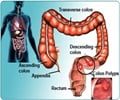Results of a new, comprehensive analysis of patient telephone records at an inflammatory bowel disease clinic revealed that 15 percent of patients account for 50 percent of all calls.

The results, which can help doctors identify patients with the most severe disease and those at risk of potentially avoidable high-cost medical interventions, were reported in a study published online this week in the journal Clinical Gastroenterology and Hepatology.
Inflammatory bowel diseases (Crohn's disease and ulcerative colitis) are chronic lifelong conditions which affect the gastrointestinal tract of up to 2 million Americans, the majority of whom are diagnosed as young adults. Telephone communication in IBD care is common, and involves reporting clinical status, treatment, reassurance, and completion of health care forms and insurance authorization. Yet, until now, there has been limited information on telephone activity volume or the reasons for calls in the care of chronic illness, including IBD.
"Telephone surveillance and the use of big data allowed us to find red flags identifying patients at risk of high-cost medical interventions, such as emergency department use and/or hospitalization. These findings can help to identify disease severity and teach us how to take better care of our patients," noted senior author David Binion, M.D., visiting professor of medicine, clinical and translational science and co-director of the IBD Center at the University of Pittsburgh School of Medicine.
Researchers tracked more than 50,000 phone calls over a period of two years, from over 3,000 patients. The researchers assessed associations between clinical factors and logged telephone encounters, and between patterns of telephone calls and future visits to the emergency room or hospitalization.
Calls were categorized into five groups:
Advertisement
- Problem/follow-up (incoming calls from patients), representing 52 percent of all calls
- Resolution/plan (outgoing calls to patients), representing 25 percent of all calls Advertisement
- Refill requests/pharmacy contacts, representing 12 percent of all calls
- Insurance authorization, representing 10 percent of all calls
- Completion of forms or record requests, representing 1 percent of all calls
Researchers also measured telephone encounters logged into electronic medical records in consented subjects from a prospective IBD research registry. Patients calling more than 10 times per year were considered high telephone encounters.
Results showed that:
- Telephone calls are predictors of how likely patients are to enter the emergency room: clusters of phone calls over time were highly predictive of who ended up in the hospital over the course of the next year.
- Frequent telephone calls correlated with:
- Poorly controlled inflammation of IBD
- Patients with a high degree of pain and difficulty coping
- Poorly controlled inflammation of IBD
"We believe we will ultimately be able to use this information to prevent hospitalization, since we now have better insight into the heterogeneous factors which are getting our patients into trouble," added Dr. Binion. "Our next step is to set up an intervention trial, where patterns of telephone activity will be used as an early warning strategy to identify at-risk patients. Perhaps the most important aspect of the study was its simplicity and generalizability, as records of telephone communication in health care are an important part of electronic health records available throughout the U.S."
Source-Eurekalert










